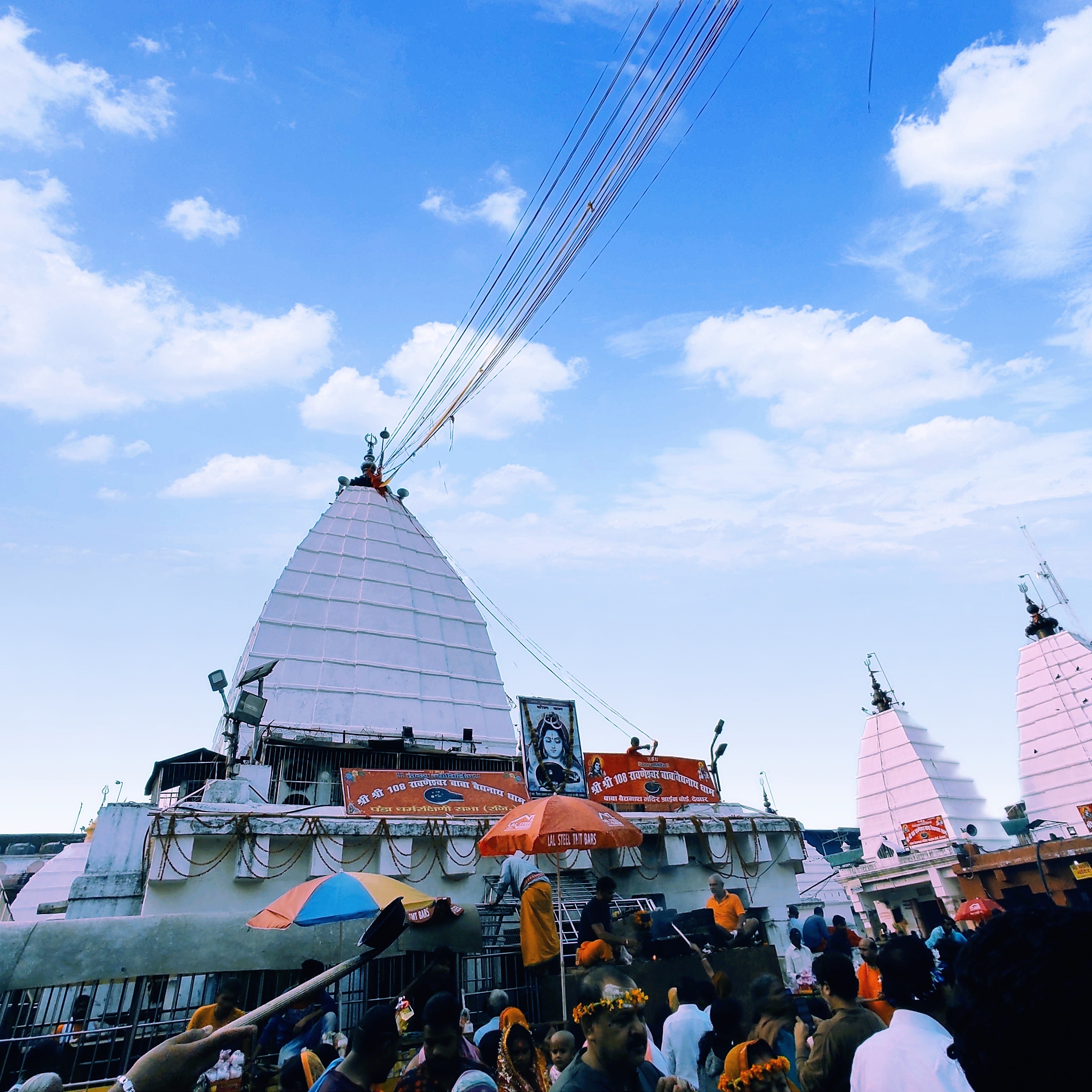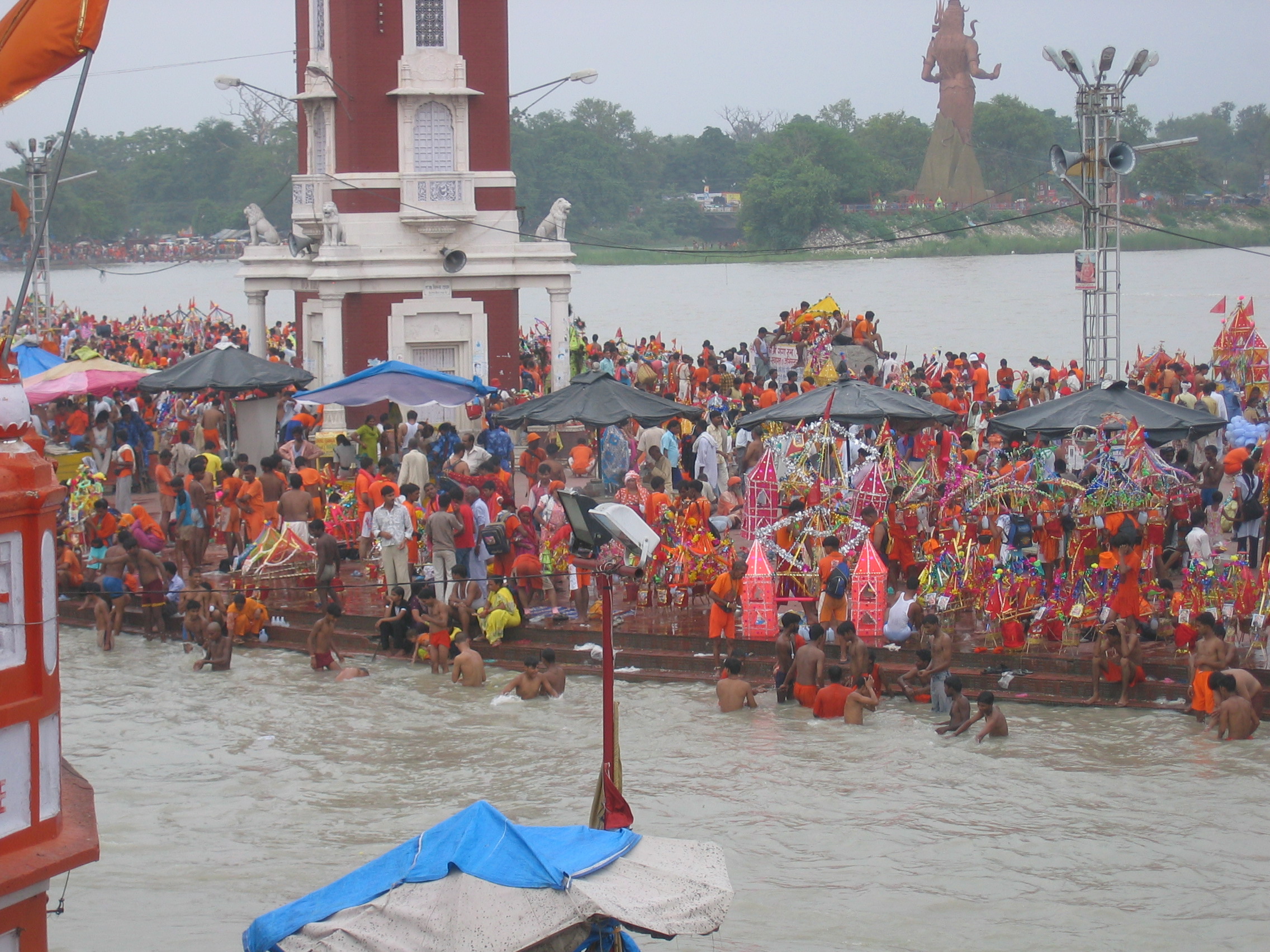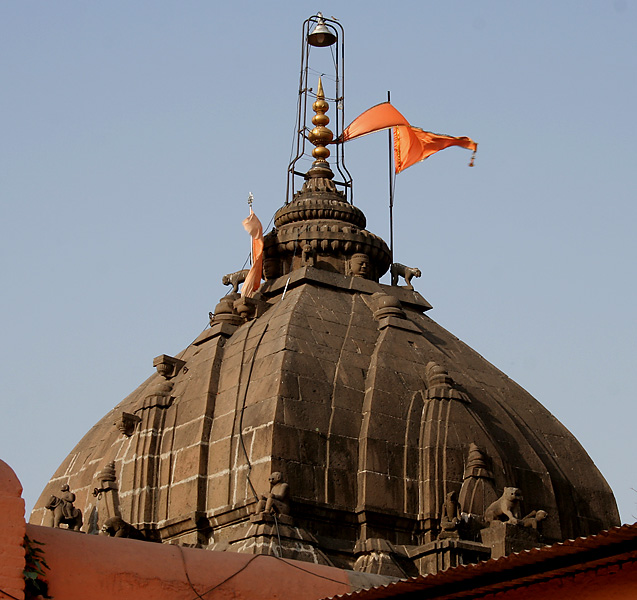|
Baidyanath
Vaidyanatha Jyotirlinga temple, also known as ''Baba Baidyanath dham'' and ''Baidyanath dham'' is one of the twelve Jyotirlingas, the most sacred abodes of Shiva. It is located in Deoghar in the Santhal Parganas division of the state of Jharkhand, India. It is a temple complex consisting of the main temple of Baba Baidyanath, where the Jyotirlinga is installed, and 21 other temples. According to Hindu beliefs, the demon king Ravana worshipped Shiva at the current site of the temple to get the boons that he later used to wreak havoc in the world. Ravana offered his ten heads one after another to Shiva as a sacrifice. Pleased with this, Shiva descended to cure Ravana who was injured. As he acted as a doctor, he is referred to as ''Vaidhya'' ("doctor"). The temple derives its name from this aspect of Shiva. Kanwar Yatra (Devanagari: ÓżĢÓżŠÓżéÓżĄÓżĪÓż╝ Óż»ÓżŠÓżżÓźŹÓż░ÓżŠ) is an annual pilgrimage of devotees of Shiva, known as K─ünvarias (ÓżĢÓżŠÓżéÓżĄÓżĪÓż╝Óż┐Óż»ÓżŠ) or "Bhole" (Óż ... [...More Info...] [...Related Items...] OR: [Wikipedia] [Google] [Baidu] |
Deoghar District
Deoghar district (pronounced, ''Devo ka ghar'') is one of the twenty-four districts of Jharkhand state in eastern India. Deoghar, the central city of the district, is also its administrative headquarters. This district is known for the Baidyanath Jyotirlinga shrine and is a part of the Santhal Pargana division. Deoghar is a Hindi word meaning abode (ŌĆśgharŌĆÖ) of the Gods and Goddesses (ŌĆśdevŌĆÖ). Deoghar is also known as ŌĆ£Baidyanath Dham,ŌĆØ and ŌĆ£Baba Dham,ŌĆØ. History The district was formed on 1 June 1981 by separating it from the former Santhal Pargana district. Geography The Deoghar district is located in western portion of Santhal Parganas. It shares its boundary with Banka and Jamui districts in the north, Dumka in the east, Jamtara in the south, and Giridih in the west. The district extends from 24.0.03' N to 23.0.38' N and from 86.0.28' E to 87.0.04' E; it has an area of 2481 km2. It had a population of people according to the 2011 Census of India. The ... [...More Info...] [...Related Items...] OR: [Wikipedia] [Google] [Baidu] |
Deoghar
Deoghar (pronounced ''Devaghar'') is a major city in Jharkhand, India. It is a holy sacred place of Hinduism. It is one of the 12 ''Jyotirlinga''s sites of Hinduism (Baidyanath Temple). The sacred temples of the city make this a place for pilgrimage and tourists. The city is administrative headquarter of Deoghar District at Santhal Parganas division of Jharkhand. Etymology Deoghar is a Hindi word and the literal meaning of ŌĆśDeogharŌĆÖ is abode (ŌĆśgharŌĆÖ) of the Gods and Goddesses (ŌĆśdevŌĆÖ). Deoghar is also known as ŌĆ£Baidyanath DhamŌĆØ, ŌĆ£Baba DhamŌĆØ, ŌĆ£B. DeogharŌĆØ. The origin of Baidyanathdham is lost in antiquity. It has been referred to as Haritakivan or Ketakivan in Sanskrit Texts. The name Deoghar seems to be of recent origin and probably dates from the erection of the great temple of Lord Baidyanath. Although the name of the builder of the temple is not traceable, certain parts of the front portion of the temple are said to have been built by Puran Mal, an an ... [...More Info...] [...Related Items...] OR: [Wikipedia] [Google] [Baidu] |
Jyotirlinga
A Jyotirlinga () or Jyotirlingam, is a devotional representation of the Hindu god Shiva. The word is a Sanskrit compound of ('radiance') and ('sign'). The ┼Üiva Mah─üpur─üß╣ćam (also ''Shiva Purana'') mentions 64 original ''jyotirlinga'' shrines in India, 12 of which are most sacred and they are called the Maha Jyotirlingam (The Great Jyotirlinga.) Hinduism Legend According to a Shaiva legend from the Shiva Purana, once, Brahma (the god of creation) and Vishnu (the god of preservation) had an argument over their supremacy. To settle the debate, Shiva pierced the three worlds, appearing as a huge, infinite pillar of light, the ''jyotirlinga.'' Brahma and Vishnu decided to ascend and descend across the pillar of light respectively, to find the end of the light in either direction. According to some iterations, Vishnu assumed his Varaha avatar to achieve this task, while Brahma rode a hamsa (swan). Brahma lied that he had discovered the end of the light, producing a ketak ... [...More Info...] [...Related Items...] OR: [Wikipedia] [Google] [Baidu] |
Jharkhand
Jharkhand (; ; ) is a state in eastern India. The state shares its border with the states of West Bengal to the east, Chhattisgarh to the west, Uttar Pradesh to the northwest, Bihar to the north and Odisha to the south. It has an area of . It is the 15th largest state by area, and the 14th largest by population. Hindi is the official language of the state. The city of Ranchi is its capital and Dumka its sub-capital. The state is known for its waterfalls, hills and holy places; Baidyanath Dham, Parasnath, Dewri and Rajrappa are major religious sites. The state was formed on 15 November 2000, after carving out what was previously the southern half of Bihar. Jharkhand suffers from what is sometimes termed a resource curse: it accounts for more than 40% of the mineral resources of India, but 39.1% of its population is below the poverty line and 19.6% of children under five years of age are malnourished. Jharkhand is primarily rural, with about 24% of its population living in ... [...More Info...] [...Related Items...] OR: [Wikipedia] [Google] [Baidu] |
Shakti Peethas
The Shakti Pitha or the Shakti Peethas ( sa, ÓżČÓżĢÓźŹÓżżÓż┐ Óż¬ÓźĆÓżĀ, , ''seat of Shakti'') are significant shrines and pilgrimage destinations in Shaktism, the goddess-centric denomination in Hinduism. The shrines are dedicated to various forms of Adi Shakti. Various Puranas such as Srimad Devi Bhagavatam state the existence of varying number of 51, 64 and 108 Shakti peethas of which 18 are named as Astadasha ''Maha'' (major) in medieval Hindu texts. Various legends explain how the Shakti Peetha came into existence. The most popular is based on the story of the death of the goddess Sati. Out of grief and sorrow, Lord Shiva carried Sati's body, reminiscing about their moments as a couple, and roamed around the universe with it. Lord Vishnu had cut her body into 51 body parts, using his Sudarshana Chakra, which fell on Earth to become sacred sites where all the people can pay homage to the Goddess. To complete this massively long task, Lord Shiva took the form of Bhairava. ... [...More Info...] [...Related Items...] OR: [Wikipedia] [Google] [Baidu] |
Pural Mal Of Gidhaur
Puran Mal was king of Gidhaur in 16th century. He was contemporary of Mughal Emperor Akbar. According to legend, he resorted Baidyanath Temple of Deoghar. Reign His previous generation were supported Sher Shah Suri against Mughal. In 1580 he supported rebellion against the Mughal by Masum Khan Kabuli. He also clashed with the chief of Kharagpur Raj, Sangram Singh. After suppression of rebellion, he supported Mughal expedition led by Shahbaz Khan Kamboh against the Afghans in Bengal and Odisha. Puran Mal was successful in establishing friendship with Shahbaz Kamboh and attacked Sangram Singh of Kharagpur. Sangram Singh had to seek shelter in forest. Puran Mal became powerful in the reign. But a when Rajput follower of Puran Mal allied with Sangram Singh, attempted to kill Shahbaz Khan Kamboh but killed another person in confusion, Shahbaz Khan Kamboh imprisonmed Puran Mal in suspect. But later the assailant arrested and killed and Puran Mal released from Mughal imprisonment. Then ... [...More Info...] [...Related Items...] OR: [Wikipedia] [Google] [Baidu] |
Kanwar Yatra
The K─ünvar (or K─ünwar/ K─üvaßĖŹ) Y─ütr─ü (Devanagari: ÓżĢÓżŠÓżéÓżĄÓżĪÓż╝ Óż»ÓżŠÓżżÓźŹÓż░ÓżŠ) is an annual pilgrimage of devotees of Shiva, known as ''K─ünvarias''(ÓżĢÓżŠÓżĄÓżĪÓż╝Óż┐Óż»ÓżŠ) or "Bhole" (ÓżŁÓźŗÓż▓Óźć), to Hindu pilgrimage places of Haridwar, Gaumukh and Gangotri in Uttarakhand and Sultanganj in Bihar to fetch holy waters of Ganges River. Millions of pilgrims fetch sacred water from river Ganga and carry on their shoulders for hundreds of miles to offer it in their local ┼Üiva shrines, or specific temples such as Pura Mahadeva and Augharnath temple in Meerut, and Kashi Vishwanath, Baidyanath, and Deoghar in Jharkhand. At its base, Kanwar refers to a genre of religious performances where participants ritually carry water from a holy source in containers suspended on either side of a pole. The pilgrimage derives its name from the contraption, called kanwar, and while the source of the water is often the Ganga, it can also be its local equivalents. The offerin ... [...More Info...] [...Related Items...] OR: [Wikipedia] [Google] [Baidu] |
Bhairava
Bhairava (Sanskrit: ÓżŁÓźłÓż░ÓżĄ ) or Kala Bhairava is a Shaivite and Vajray─üna deity worshiped by Hindus and Buddhists. In Shaivism, he is a powerful manifestation, or avatar, of Shiva associated with annihilation. In Trika system ''Bhairava'' represents Supreme Reality, synonymous to Para Brahman.Christopher WalliTantra Illuminated/ref> Generally in Hinduism, Bhairava is also called Dandapani (" e who holds theDanda in ishand"), as he holds a rod or Danda to punish sinners, and Sva┼øva, meaning "whose vehicle is a dog". In Vajrayana Buddhism, he is considered a fierce emanation of boddhisatva Ma├▒ju┼ør─½, and also called Heruka, Vajrabhairava, and Yamantaka. He is worshiped throughout India, Nepal and Sri Lanka as well as in Tibetan Buddhism. Etymology Bhairava originates from the word ''bh─½ru'', which means "fearsome". Bhairava means "terribly fearsome form". It is also known as one who destroys fear or one who is beyond fear. One interpretation is that he protects hi ... [...More Info...] [...Related Items...] OR: [Wikipedia] [Google] [Baidu] |
India
India, officially the Republic of India (Hindi: ), is a country in South Asia. It is the seventh-largest country by area, the second-most populous country, and the most populous democracy in the world. Bounded by the Indian Ocean on the south, the Arabian Sea on the southwest, and the Bay of Bengal on the southeast, it shares land borders with Pakistan to the west; China, Nepal, and Bhutan to the north; and Bangladesh and Myanmar to the east. In the Indian Ocean, India is in the vicinity of Sri Lanka and the Maldives; its Andaman and Nicobar Islands share a maritime border with Thailand, Myanmar, and Indonesia. Modern humans arrived on the Indian subcontinent from Africa no later than 55,000 years ago., "Y-Chromosome and Mt-DNA data support the colonization of South Asia by modern humans originating in Africa. ... Coalescence dates for most non-European populations average to between 73ŌĆō55 ka.", "Modern human beingsŌĆö''Homo sapiens''ŌĆöoriginated in Africa. Then, int ... [...More Info...] [...Related Items...] OR: [Wikipedia] [Google] [Baidu] |
Parli, Maharashtra
Parli Vaijnath is a city and a municipal council in Beed district in the Indian state of Maharashtra. It is the headquarters of the Parli taluka of Beed district. It is a holy city of sacred importance where many historical places still exist. About Parli is in Beed district identified by Shri Vaijnath Temple. Vaijnath temple is the one of the 12 Jyotirlinga in India and Maharashtra State Power Generation Company Limited Parli Thermal Power Station. Other major industries include Vaijnath Sugar Factory,The India Cements Ltd and Ghawalkar Engine,Transmission and Motor Repair and Overhaul Facility. The Head office of Vaidyanath Co-Operative Bank is located in Parli. One of the biggest fair in Maharashtra takes place here on Mahashivratri. Parli is the largest taluka place in Marathwada region of Maharashtra. In Mythology It is said that Savitri and Satyavan lived here, and the famous incident of Savitri taking back her beloved husband's life from Yamraj took place here, around ... [...More Info...] [...Related Items...] OR: [Wikipedia] [Google] [Baidu] |
Lord Shiva
Shiva (; sa, ÓżČÓż┐ÓżĄ, lit=The Auspicious One, ┼Üiva ), also known as Mahadeva (; ╔É╔”a╦Éd╠¬e╦É╩ŗ╔É, or Hara, is one of the principal deities of Hinduism. He is the Supreme Being in Shaivism, one of the major traditions within Hinduism. Shiva is known as "The Destroyer" within the Trimurti, the Hindu trinity which also includes Brahma and Vishnu. In the Shaivite tradition, Shiva is the Supreme Lord who creates, protects and transforms the universe. In the goddess-oriented Shakta tradition, the Supreme Goddess (Devi) is regarded as the energy and creative power (Shakti) and the equal complementary partner of Shiva. Shiva is one of the five equivalent deities in Panchayatana puja of the Smarta tradition of Hinduism. Shiva has many aspects, benevolent as well as fearsome. In benevolent aspects, he is depicted as an omniscient Yogi who lives an ascetic life on Mount Kailash as well as a householder with his wife Parvati and his three children, Ganesha, Kartikeya and As ... [...More Info...] [...Related Items...] OR: [Wikipedia] [Google] [Baidu] |
Himachal Pradesh
Himachal Pradesh (; ; "Snow-laden Mountain Province") is a state in the northern part of India. Situated in the Western Himalayas, it is one of the thirteen mountain states and is characterized by an extreme landscape featuring several peaks and extensive river systems. Himachal Pradesh is the northernmost state of India and shares borders with the union territories of Jammu and Kashmir and Ladakh to the north, and the states of Punjab to the west, Haryana to the southwest, Uttarakhand to the southeast and a very narrow border with Uttar Pradesh to the south. The state also shares an international border to the east with the Tibet Autonomous Region in China. Himachal Pradesh is also known as , meaning 'Land of Gods' and which means 'Land of the Brave'. The predominantly mountainous region comprising the present-day Himachal Pradesh has been inhabited since pre-historic times, having witnessed multiple waves of human migrations from other areas. Through its history, the ... [...More Info...] [...Related Items...] OR: [Wikipedia] [Google] [Baidu] |







